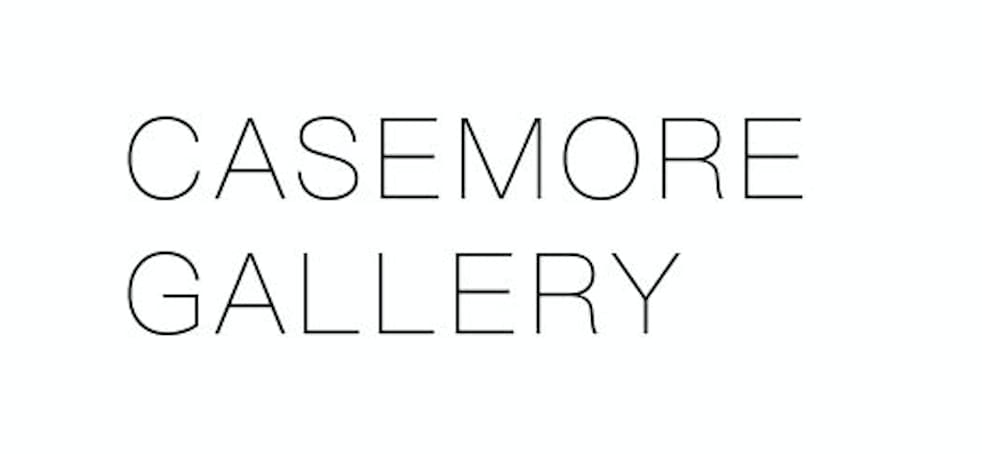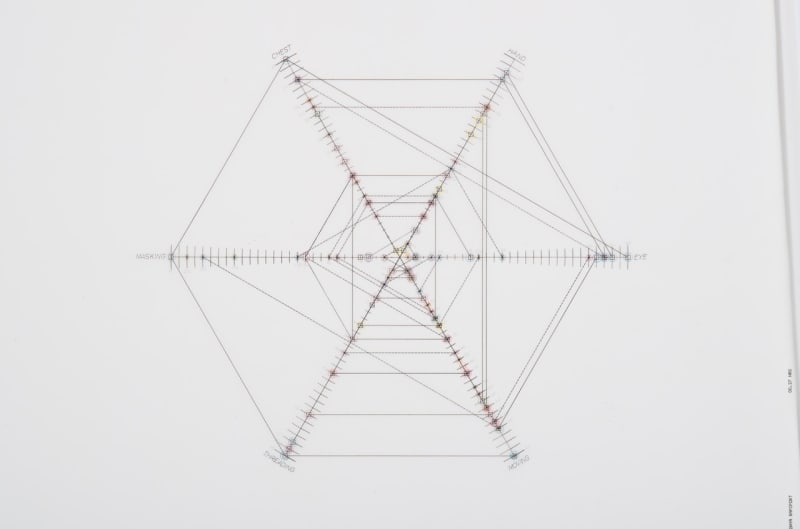Force Fields
Early Computer Art and Works on Paper by Sonya Rapoport
April 1st – May 13th, 2023
Opening Reception: 5 – 7pm, Saturday, April 1st, 2023
Casemore Gallery presents an exhibition of works on paper by Sonya Rapoport (1923-2015), recognized as a pioneer of computer art. The exhibition explores the evolution of her engagement with the computer, from her earliest drawings on computer printout paper in the late 1970s, through her computer-mediated “audience participation performances” in the 1980s.
Rapoport–whose work is currently on view in the exhibition Coded: Art Enters the Computer Age, 1952-1982at Los Angeles County Museum of Art–began using the computer in her practice in 1976, when she found discarded continuous-feed computer printout paper in a bin in the basement of the UC Berkeley mathematics building. Drawn to the futuristic aesthetic of sprocket holes, grid lines, and carbon-black, dot-matrix printed code, she drew into the existing patterns with graphite, colored pencil, and ink stamps, and stitched the construction together with colorful yarn to create drawings such as “Right-On” (1976), on view in the current show.
In 1977 Rapoport wrote, “my work is an aesthetic response triggered by scientific data. The format is computer print-out, a ritualistic symbol of our technological society.”
By the early 1980s, Rapoport had learned to code and was using the computer to analyze and visualize data. At a time when computers were primarily used for business, science, and military applications, Rapoport was gathering and processing data about what she called “soft material,” including her biorhythms, her shoe collection, her home, and the objects on her dresser, an approach she characterized as a feminist use of new technology.
In “A 20th Century Portrait (Unknown)” (1979), part of Rapoport's Objects On my Dresser series, she represents her subject as a multidimensional “netweb” plot, perhaps referring to the analytical, quantitative perceptions of the computer. But behind this enigmatic image is a social interaction where Rapoport discussed the objects on her dresser with an unknown subject–an idiosyncratic personality test of sorts. The related large-scale drawing “Surface” (1981) features photocopied images and appropriated text on computer paper that reveal the complex, interconnected psychological relationships Rapoport had with the objects on her dresser.
“Shoe-Field” (1982-1989) began with a performance at a home computer store in Berkeley, where participants were asked how they felt about their shoes. Their answers were analyzed by a computer and given a printed “Shoe-Psyche Plot” that represented their feelings as an electromagnetic force field printed in ASCII characters. Rapoport’s artistic process–which she described as “quantifying qualitative information”–can be seen in a video that documents the interactive performance of “Shoe-Field” at Media Gallery, San Francisco in 1986.
In his essay “A Throw of the Dice: Between Structure and Indeterminacy” 2012, Richard Cándida-Smith wrote “Rapoport’s use of technology should not blind us to the fact that she is working out a structure of human interactions, even if they are based on their relationships with inanimate objects, their shoes.”
Sonya Rapoport (1923-2015) was an American artist with a pioneering conceptual, feminist art practice spanning six-decades. Rapoport was among the first women to receive an MA in Painting at UC Berkeley in 1949. She was active in a community of artists experimenting with technology and psychology, taking a leadership role in the new media journal Leonardo (MIT Press). Rapoport’s opulently colored, enigmatically structured paintings from the early 1970’s feature a coded language of stencils representing the female body. Later in the decade, Rapoport made a remarkable shift to embracing information technology. In the era of room-sized computers programmed with punch cards, at the time confined primarily to the purview of big business and scientific research, Rapoport began experimenting with continuous-feed computer paper. Drawn to the then-futuristic aesthetic of sprocket holes, grid lines, and cryptic inscriptions, Rapoport drew into existing patterns with graphite, colored pencil, and ink stamps, and stitched constructions together with colorful yarn. She later programmed computers to create dense visual representations of information about her daily life, including her shoe collection, the objects on her dresser, and her family. Her legacy includes paintings, drawings, interactive computer installations, and web art.
Her work has been featured in Documenta 8 (1987), Whitney Biennial (2016), and has been collected by MoMA New York, The Getty Research Institute, The Victoria & Albert Museum, SFMOMA, Berkeley Art Museum, and the San Jose Museum of Art. Rapoport’s work is currently featured in Coded: Art Enters the Computer Age, 1952-1982 at LACMA through July 2, 2023.


